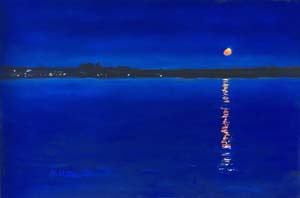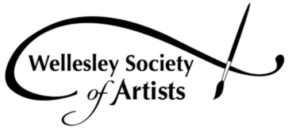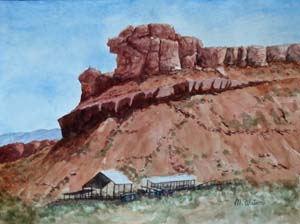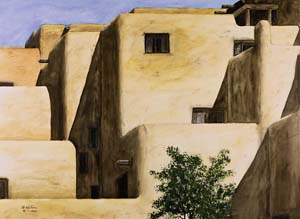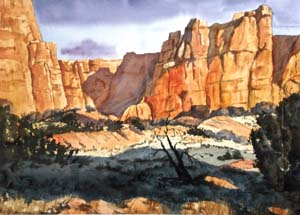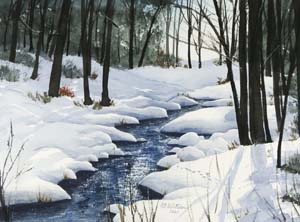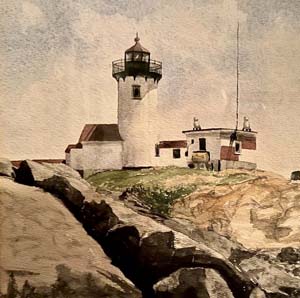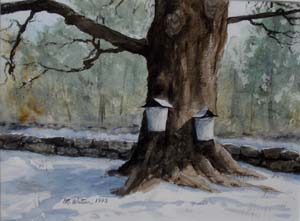January Artist of the Month
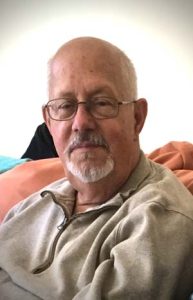
Meet Mick Watson
First off, I turn 80 in a week, and if I make it to 80, I figure life doesn’t owe me anything. As I write this piece, it occurs to me that I have spent half my life—40 years–as a part-time artist. Here’s the story.
After receiving a Ph.D. in Developmental Psychology, I spent 40 years as a professor at Brandeis University, where I taught and mentored students and did research. The main focus of my research was on aggression and bullying in children and adolescents, far removed from art. I loved my career, but at 73 I was ready to retire and put it all behind me. Since then I haven’t looked back but have spent much of my retirement writing (not the previous research articles and grant proposals, but short stories, essays, and travelogues), playing bass in a jazz group, and painting with watercolors and pastels. So making art, which I did infrequently in the first half of my life, I now do much of the time. Why? Let me see if I can figure out an answer to that question—why I make art?
First, a review of the research on children’s developing art making. In the verbal realm, babies early on start cooing and then start babbling by adding consonants. It’s nonsense, but it quickly leads them to pick up various sounds and syllables and then words and then sentences and eventually longer conversations. And along the way, they discover the aesthetic side of language—emotional metaphors, humor, poetry.
There is a parallel development in the graphic realm. Just like babbling without meaning, almost all young children, if given the opportunity, start scribbling and making marks without meaning. This kind of “graphic babbling” develops into subroutines that are then combined to make marks that are recognizable representations of things in the world—faces, people, trees, and so forth. Eventually these symbols are combined into stories and scenes, similar to sentences and then paragraphs in speaking. And these budding artists begin to see the aesthetic and emotional aspects that are available in art. Then, when so many children are going strong as emerging artists—at about eight years of age, the majority of children stop doing artwork. But some continue until puberty, and then they also drop out. Only a few go on making art after puberty and into adulthood, and a few of them become really good artists, like those in the Wellesley Society of Artists. It is not so clear why so many drop out. After all, we don’t drop out from using language, maybe because we all need language, but society doesn’t so much see the necessity of art skills.
As a young child, I loved to make art and drew and painted almost daily. It calmed me, and it gave me a chance to create pictures and try to accurately copy things in my world. I made it past eight years of age, but I became a puberty drop out. After that, I did no art until I was about 40 years of age. I took no art classes, but I looked at art—I would stare at paintings for a long time. I was often transfixed by them. And then gradually I started sketching again and in time tentatively took up watercolor painting. For a long time, I was afraid of using brushes and paint, but I read a few books on how to paint, and over time attended some art demonstrations. My break-through came when I bought quality art materials, such as Windsor-Newton watercolor paints, and quality paper, such as Arches, and good brushes, and a good artist table. Later, I added good pastels. (I love watercolors, but I truly love the colors of pastels, even though they are extremely messy.) And then it all clicked, and now I paint often.
When I am doing art, I don’t like others to be around. Art making for me is a solitary activity. I usually paint in my “studio,” such as it is, and turn up jazz quite loud and go at it for about 4 to 5 hours at a time. I usually quietly concentrate, but I sometimes dance around. And when I have completed a painting, I put it on an easel and stare at it for an hour or two and then return to look at it and perhaps tweak it over the next few days, or I rip it up and start over. Sometimes I crop it—cut it back—to capture the picture I really want, which might be buried in the total painting.
I’m not good at painting faces that look like the person I intended. We are so hard-wired to recognize faces and subtle changes and emotions shown in them. So it isn’t surprising that it is difficult for an artist to capture the subtleties of an individual face. I stand in awe of those who can capture specific faces and emotions.
A confession–I have never taken an art class. That’s probably foolish on my part and not something to be proud of, as I know I could learn a lot from art classes and good teachers, but perhaps in keeping with my view of my art being solitary, I don’t want to take a class and break my record at this point.
To keep myself loose, I intermittently paint an abstract, but most of the time I paint representational scenes and objects that I observe live or usually in multiple photographs I have taken of a particular scene. I take a lot of photos. And sometimes I get one of my sons to take photos for me of places I know about but can’t reach to use as models in my painting. I used to live in New Mexico and in Utah and in Colorado, and I love painting pictures of the Southwest—New Mexico, Southern Utah, and Arizona. And I love painting pictures of New England. I love unusual shots of buildings, especially of adobe and Native American pueblo buildings, and their shadows. I love the juxtaposition of tan-brown and turquoise (almost complements).
For me, art (along with playing music and writing) usually gets me into an altered state, a condition of flow, as Czikszentmihalyi called it. Some of you artists no doubt know what I mean. One loses a sense of time and connection to the daily concerns of one’s world and gets lost in the flow activity. In such a state, one does not worry about extrinsic concerns—am I a good artist, can I sell this painting, will people like it, will I win an award, will I be done in time for diner? Extrinsic motivators and constraints usually kill intrinsic motivation and flow, and in the process, full enjoyment of the experience–and creativity. For me, concern with selling a painting or hoping I am recognized or if I am creative are highly distracting and unpleasant. Nevertheless, I truly value being a member of the Wellesley Society of Artists because it gives me the chance to talk to other artists (which I usually wouldn’t do) and to show more of my paintings, because, despite all that I have said, I do hope to have a few people like and be touched by my artwork. If someone slows down and takes some time to stare at a painting of mine, that seems like a good thing. But if nobody does, well at least I had the chance to get carried away in the process of making the painting, and I will have something I like staring at. And I guess that’s my answer to the question of why I make art.